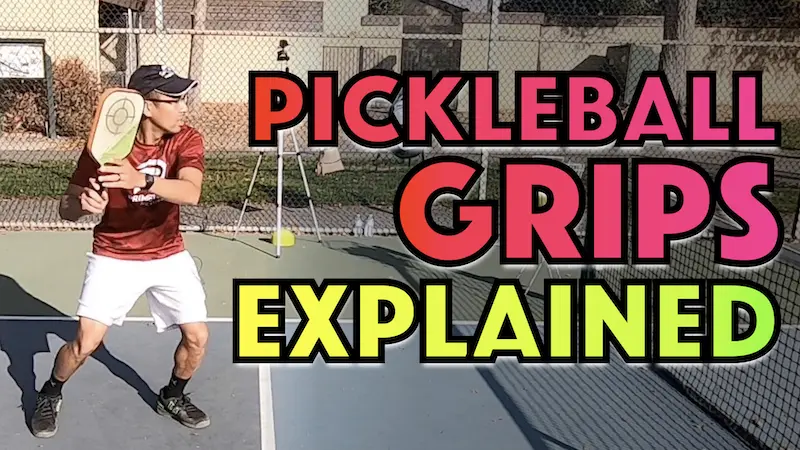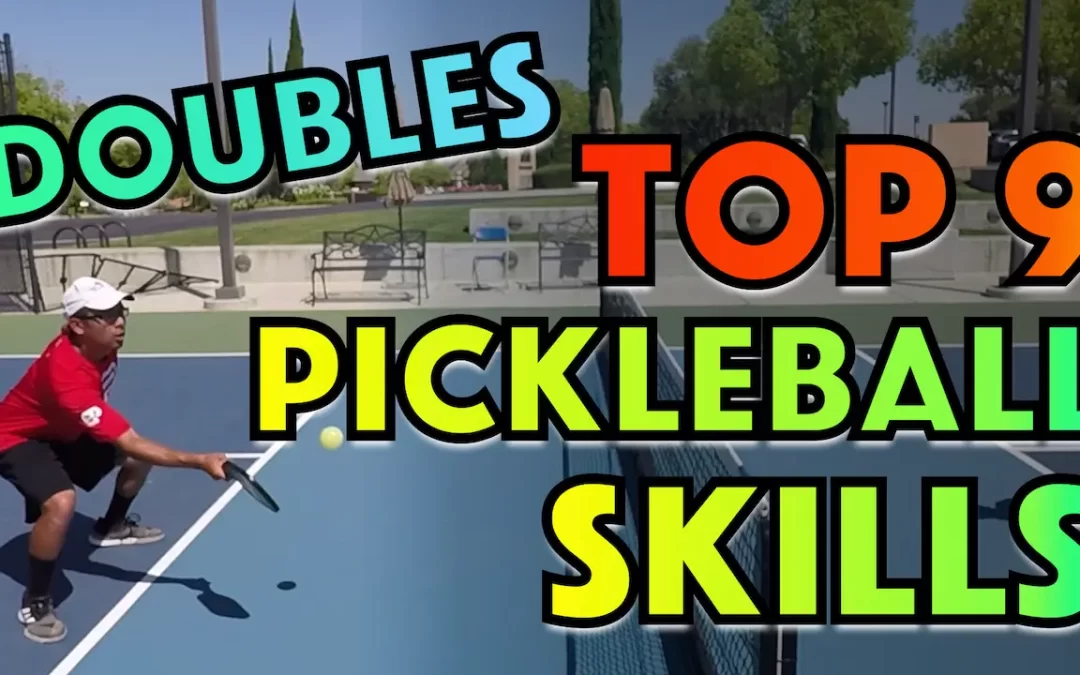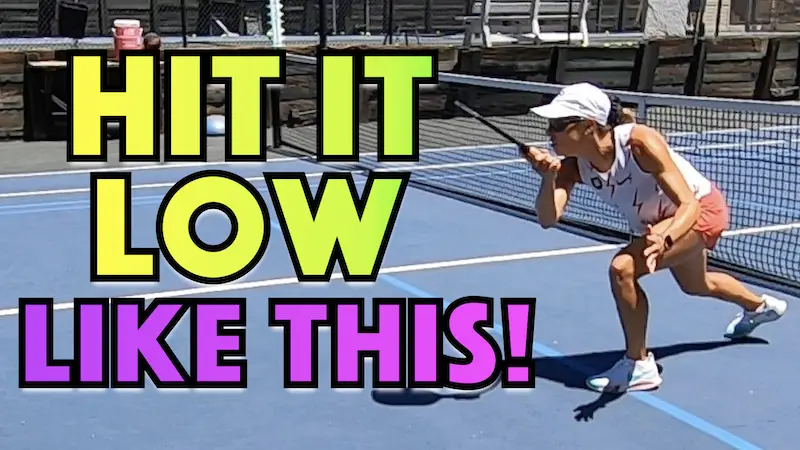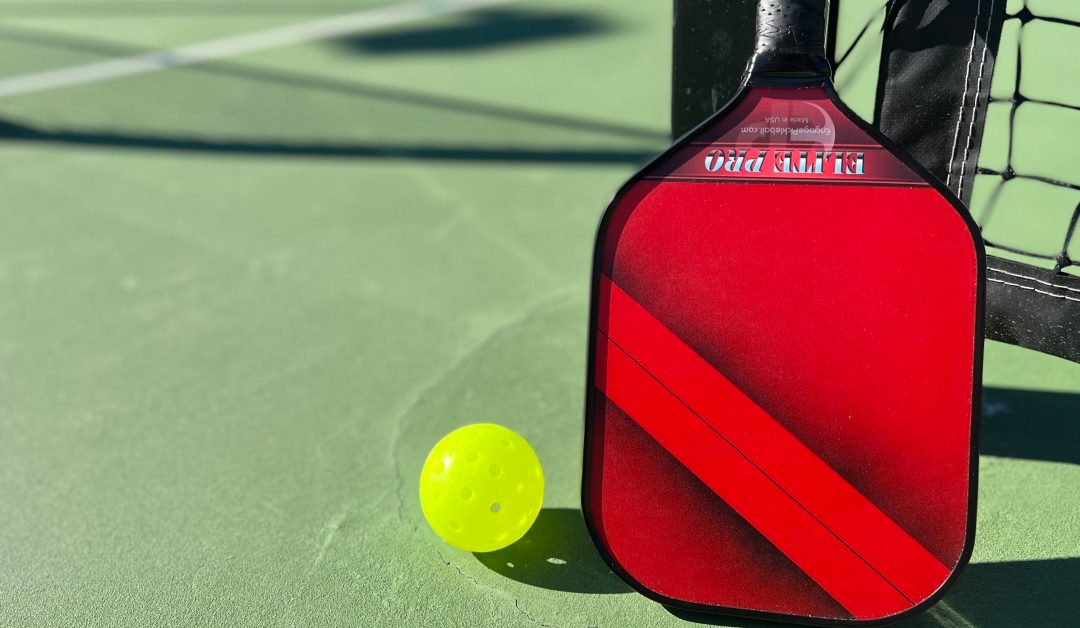Despite the popularity of pickleball and it’s being around for many years, it’s not always easy to find a pickleball court to play on.
This prompts the question: can you play pickleball on a standard tennis court?
In short, yes, you can play pickleball on a standard tennis court.
Tennis courts are perfect for playing pickleball as the court surface is ideal and the net height is close to the same. With a few minor adjustments, it can work perfectly.
You can also play on basketball courts or badminton court if they are available.
With enough space and a concrete or similar surface, many players are opting to pop up temporary courts on their driveway or in their backyard.
But, aside from having a court that was built for pickleball, a tennis court is by far the easiest of all options as a starting point on your way to having a playable pickleball court.
The biggest differences are that the line-markings aren’t the same. The solution is to mark out pickleball lines on the tennis court using the existing tennis court lines as a guide.
You can mark out a single pickleball court in the center of the tennis court as is pictured below and described in more detail below.
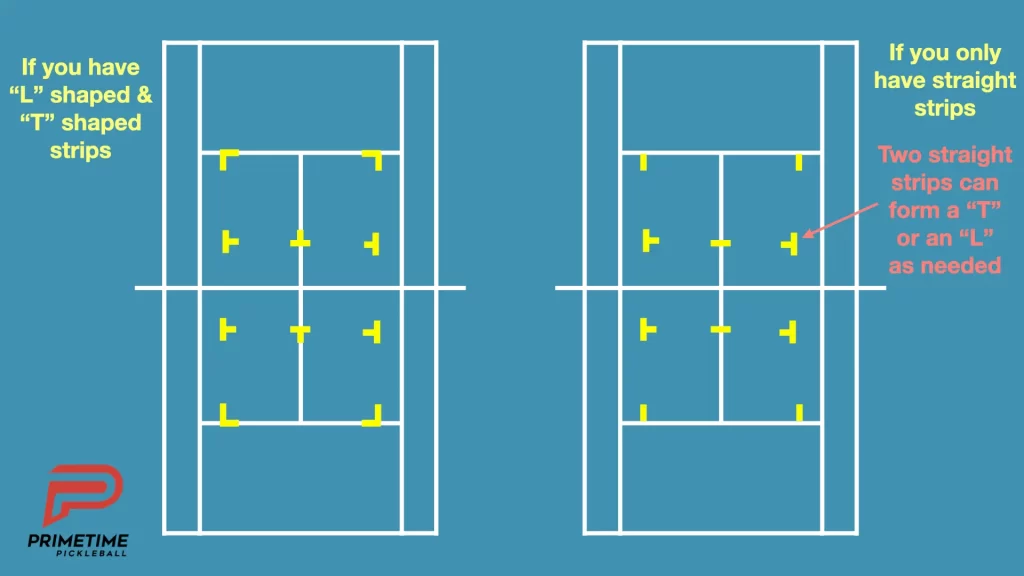
Or, you can fit up to 4 pickleball courts per tennis court, so long as the tennis court is regulation size.
If you wish to put 2 or more pickleball courts on a tennis court, you will need temporary nets since the tennis net can only accommodate one pickleball court.
Permanent vs. Temporary Pickleball Court Markings on a Tennis Court
A quick word of caution before you start marking out a pickleball court on to an existing tennis court.
Do not use marking that are permanent or semi-permanent without permission from the owner or management of the courts.
Permanent marker or paint will almost certainly be a big no-no and may even get you into legal hot water.
Adhesive tape and chalk fall into the category of semi-permanent. Depending on the tape used, a residue that is hard to remove may get left behind. Chalk will need to me washed off and although will likely will come all the way out, it could take considerable effort.
The court owner or manager may work with you but they may just as easily be very unhappy about this so proceed with caution.
Some might suggest you can use plastic cones. The upright type that football or soccer coaches use. I like them for target practice but I’m not personally a fan of cones to be used for marking out a court. Reason being that during pickleball, you are watching the ball and not the cones on the court. In my view, the safety risk is just a bit too high.
I find it to be an unnecessary obstacle especially when there’s a significantly better option that is also inexpensive.
I would suggest you use vinyl strips because if you do happen to step on them, they are flush with the court and won’t present much of an injury risk.
The strips can either be circular discs or lines. There are pickleball line kits designed specifically for this purpose such as the Franklin Sports Pickleball Court Marker Kit.
What Is the Difference Between A Pickleball Court And A Tennis Court?
The dimensions of a tennis court are much larger than the pickleball court dimensions; giving you extra space. This means you can easily set up 4 pickleball courts per tennis court.
However, some of the internal dimensions on the court are very close to those of a pickleball court.
So, if you’re only in need of one pickleball court, with a little ingenuity, you can very easily mark out your pickleball lines so they meet the basic rules using a few vinyl strips. Again, you can use cones or other items you may have lying around such as water bottles but I don’t recommend it due to safety.
The Service Area
The service area in tennis, if you consider both service boxes together, is the space starting at the net and that goes about halfway back to the baseline.
You’ll find that the tennis court’s service area is almost the same size and dimension as a pickleball court.
From the service line on one side of the net to the service line on the other side on a tennis court is 42 feet. Whereas a pickleball court is 44 feet in length. That’s a two-foot difference in the total length of the court measured from the pickleball baseline.
So, in essence, you have a one-foot difference on each side of the net.
We suggest that you accept that as is. No need to add an additional foot, as it will unnecessarily complicate the markings.
You will naturally have to modify your game a little but it will likely not be all that noticeable to you.
But for all intents and purposes, you’ll have a perfect setup for your pickleball game.
Playing using the tennis court service lines as the baseline could even help your game when you transition to playing on a regulation pickleball court because when you hit your shots you will be used to playing them within a slightly shorter distance.
So, when you ultimately play on the slightly longer, regulation pickleball court, you already have an extra safety margin built into their game.
Measuring From The Center Line and the Singles Line
The centerline is basically the same on a pickleball court as it is on a tennis court. That means that both your baseline and center lines are pre-marked and do not require any further marking.
When it comes to the width of the court, the distance from the centerline to the single tennis line is 13.5 feet on a tennis court.
This is a bit wider than the pickleball court, which is 10 feet wide.
To mark off the correct width:
- Measure 3 or 3.5 feet in from the singles line
- Place a marker on the spot. You want to place your marker on the corner of the baseline (the tennis court service line in our example) and 3-3.5 feet in from the singles line. Do so for all 4 corners where the baseline meets the sideline.
The Non-Volley Zone or Kitchen
The non-volley zone or “kitchen” as it’s known in pickleball, is seven feet from the net. Go ahead and place a strip at the seven feet point, in line with the baseline marker.
After placing your markers, you should have four points marked on each side. Two on the baseline at the corners and two at the non-volley zone line where it meets the sideline.
These four marks will give you the sideline of your pickleball court lines.
Repeat the procedure on both sides of the tennis court.
Finally, you want markers for the center line. One to designate where the centerline meets the baseline and one to designate where the centerline meets the non-volley zone line.
Repeat the procedure on both sides of the tennis court.
This helps when you are line calling and makes it easier to play as you have a visual mark to assess where the kitchen is.
It is possible to play pickleball without marking the correct pickleball court lines on the side and just play within the singles lines of the tennis court.
However, that makes the court about 30-35% bigger, which is quite a big difference and is also more taxing on the players as far as movement and court coverage.
The tennis sidelines don’t simulate the pickleball sidelines nearly as well as the tennis service line simulates the pickleball baseline.
Of course, you can use the tennis court sidelines as the pickleball sidelines if the extra running doesn’t bother you and you just don’t have the necessary materials to mark up the court. Up to you!
Net Height Adjustments
As the net height for pickleball is slightly lower in pickleball compared to tennis, you’ll need to make a few adjustments before you’re ready to play.
A tennis net is 36 inches high in the middle. This is 2 inches too high as the regulation pickleball net is 34 inches in the middle. The easiest way to adjust the tennis net is to move the strap over a few inches in once direction or the other.
This pulls the net down to the right height as most standard pickleball nets.
Just don’t forget to slide it back when you’re finished so as to leave the court as you found it.
If there’s no net center strap, you can loosen the tension on the net at the posts and lower the net to your desired height. You won’t need to adjust it much.
Just be sure to check the height in the middle of the net with a measuring tape to ensure that you’ve got it set at 34 inches before you start playing.
Just remember to return the net to the correct height when you’ve finished playing not matter what method you used to lower it.
Tennis Court Surface Compared to a Pickleball Court Surface
Both courts are typically made of a concrete base and an acrylic top coat when they are intended to be permanent. In tennis, this is typically referred to as a “hard court” because tennis courts do come in alternate materials at times such as grass or clay.
Both games can be played indoors and outdoors and the marking of tennis courts for pickleball play as described above will be the same in both cases.
Both tennis and pickleball court have a slightly textured surface so that it is non-slip. The texture is so slight that it does not affect the bounce of either a tennis ball or a pickleball ball.
Although courts can have consistent color throughout all sections of the court. Tennis courts typically come in two colors. One color for the inside of the court and one color for the outside of the court. Greens, blues and reds are used most frequently.
Pickleball courts can also come in a consistent color throughout out but often come in two or three colors. Very often the out of bounds area, the service boxes and the kitchen will be three different colors. Many colors are popping up across the country including various shades and combinations of blue, green, red, purple and grey.
How to Play Pickleball on a Tennis Court
Once you start playing, you’ll find that there are a few unique problems that occur on a tennis court.
If you did happen to sue cones are some other upright object, you may find that the cone sometimes gets in the way of your swing or the ball may hit the cone.
If that happens, then just call a let and replay the point.
Calling an out in pickleball when you’re playing on a non-standard court is always a challenge since many parts of the line are imaginary and you have to guesstimate.
To enjoy yourself, just keep playing when it’s close or give your opponent the point.
There’s really no point in arguing over the point as the whole purpose is to have fun and get out there and play.
Agree on this before the game starts so that there are no sore losers.
If you want to get more serious and competitive then it’s time to find a permanent court or at least lined temporary courts with a sturdy temporary net.
Expect to get a bit of extra exercise. The fencing will be farther away since it was designed for a tennis court so you will often be retrieving balls between points at a greater distance.
Final Thoughts
Tennis courts are very useful for playing pickleball as the surface is similar. The dimensions marked on a tennis court also closely match pickleball court sizes.
To learn more about how you can enjoy pickleball, check out our informative blog posts, videos, and other helpful content.

